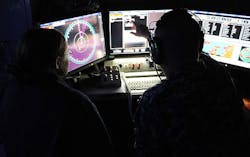Navy asks Northrop Grumman to build new shipboard laser weapon that builds on LaWS technologies
Officials of the Office of Naval Research (ONR) in Arlington, Va., announced a $53.2 million contract Thursday to the Northrop Grumman Aerospace Systems segment in Redondo Beach, Calif., for the initial phase of the Solid State High Power Laser Weapon System Demonstrator (LWSD) program.
LWSD seeks to build a laser weapon prototype that builds on technologies developed for the Navy's AN/SEQ-3(XN-1) Laser Weapon System (LaWS), which deployed last year on the amphibious transport dock USS Ponce to counter unmanned and light aircraft, as well as small attack boats.
In future LWSD demonstrations, Northrop Grumman will demonstrate an enhanced laser weapon from a surface test ship in live-fire engagements during day and night conditions for ship self-defense missions that would include destroying or disabling fast attack boats, unmanned aerial vehicles (UAVs), and sensor systems used for intelligence, surveillance, and reconnaissance (ISR), Navy officials say.
LaWS is the first laser weapon system approved for deployment by any U.S. military service. Navy officials say that LaWS technology could be even more lethal with adjustments to the laser weapon's power, beam quality, beam director architecture, beam director, and system design. These are the enhancements that the LWSD program seeks to achieve.
The Northrop Grumman team is ready to support the three phases of the LWSD program, Navy officials say. Thursday's contract has options that could increase its value to $91.1 million.
The LWSD program is an extension of long-term Navy plans to develop shipboard laser weapons that can acquire, track, identify, engage, and defeat a variety of surface vessels, manned and unmanned aircraft, and missiles.
While the LaWS weapon is as powerful as 15 to 50 kilowatts, the LWSD program seeks to increase shipboard laser weapons power to 100 to 150 kilowatts using existing ship power and cooling.
story continues below
Navy experts will install the Northrop Grumman-built LWSD aboard the former Spruance-class destroyer USS Paul F. Foster, which is the Navy’s self-defense test ship, for at-sea demonstrations. The Foster has typical shipboard power, cooling, and sensors. The goal of the planned tests aboard the Foster is to engage surface vessel, aircraft, and missile targets with better performance than LaWS.
The LWSD will have a high-power solid-state laser subsystem, beam director subsystem, targeting and tracking subsystem, fire-control subsystem, and power or cooling subsystems that interface with existing shipboard systems.
While initial at-sea tests will be aboard the Foster, Navy experts later may install and test the system aboard a commissioned late-model Burke-class destroyer, officials say.
Northrop Grumman experts will explore design tradeoffs between laser power, beam quality, optical path, duty cycle, aperture, mechanical robustness, and other physical and optical attributes to enhance the LWSD's lethality, integration, sustainability, and reliability previous designs.
Related: Navy asks industry to build ship solid-state laser weapon for realistic testing at sea
Company experts also will consider scalable architectures for lower and higher power levels; adjustable power on target to provide a range of effects from deny to disrupt, damage, and defeat; beam director and tracking technologies for low jitter; ruggedizing the system against the effects of corrosion, shock, vibration, moisture, and electromagnetic environmental effects.
At-sea testing will last at least on month aboard the Foster, during which Northrop Grumman will provide system interfaces to simulate the Navy’s AEGIS combat system, and package the LWSD for future re-installation on a Burke-class destroyer with minimal modifications.
Northrop Grumman experts will integrate the LWSD prototype with the laser weapon console developed under the LaWS program, as well as with the Hybrid Predictive Avoidance Safety System (HPASS) -- a safety system that prevents interference with satellites during testing.
On this contract Northrop Grumman will do the work in Redondo Beach, Calif., and should be finished by October 2016. For more information contact Northrop Grumman Aerospace Systems online at www.northropgrumman.com, or the Office of Naval Research at www.onr.navy.mil.
